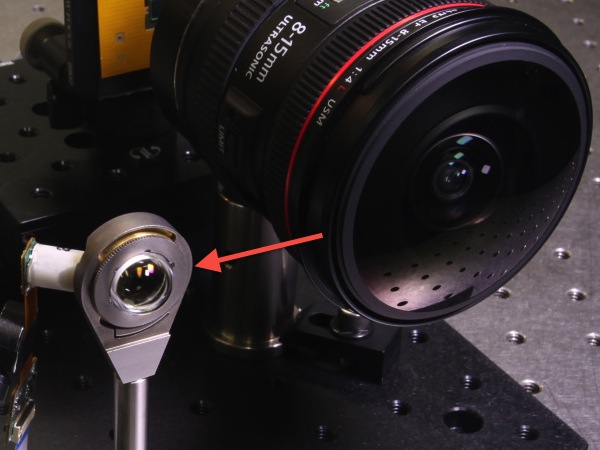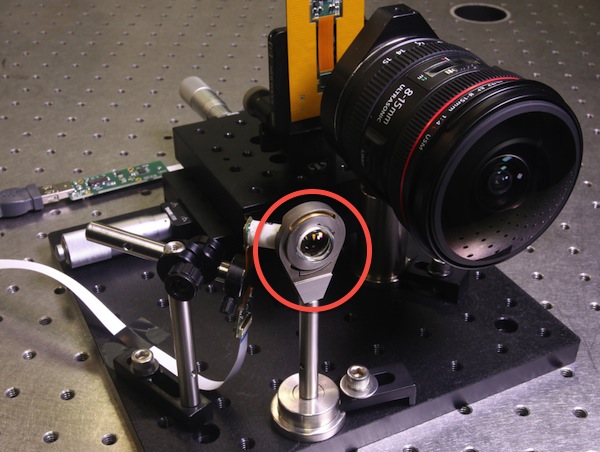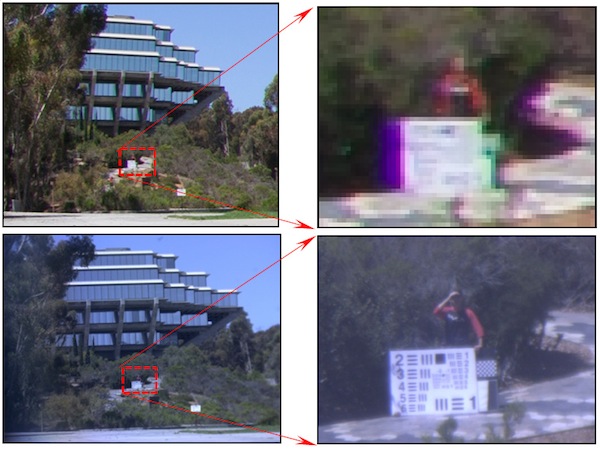Marblelike Lens for Smartphones Could Be DSLR Killer
Small enough to fit in a cellphone, a tiny spherical lens attached to fiber-optic cables can pull in crisp images from a third of a mile away.


Smartphone cameras might be getting bigger in a small way. Researchers from the University of California, San Diego have developed a wide-angle lens that’s one-tenth the size of those similarly powerful components. The camera, which is small enough to fit in most smartphones, can reliably focus on objects as far away as 500 meters (1,650 feet, or nearly a third of a mile), making it as powerful as a full-size SLR camera.
MORE: Why the iPhone 5S Will Kill Your Point-and-Shoot Camera
Sample images provided by the researchers demonstrate the lens’s clarity. In one photo, a sign held by a person in the distance is clearly legible; in the same photograph taken with a traditional wide-angle lens, the text on the sign is blurry and indistinct.
To achieve this effect, the researchers created something called a fiber-coupled monocentric lens — a lens using concentric, rounded glass shells shaped like marbles. The symmetry and shape of the lens allows the camera to capture wide-angle, high-resolution images that suffer from virtually no distortion — unlike traditional fish-eye lenses. The team overcame another problem common to wide-angle lenses — transferring the highly detailed image captured by the lens to the camera’s image sensor — by aligning glass optical fiber bundles with the lens’s surface.

However, the researchers have not addressed how large pictures taken with such a lens will be. Given the small storage capacity of most phones, anyone taking ultra-high-resolution photos may quickly run out of space. Such considerations will likely affect the speed with which smartphone manufacturers adopt this new technology.
Follow us @tomsguide, on Facebook and on Google+.
- Best Free Photo Management Tools
- Smartphone Camera Shootout 2013
- Sony's Lens-Style Cameras: Last Gasp for Point-and-Shoots?
Sign up to get the BEST of Tom's Guide direct to your inbox.
Get instant access to breaking news, the hottest reviews, great deals and helpful tips.
Tom's Guide upgrades your life by helping you decide what products to buy, finding the best deals and showing you how to get the most out of them and solving problems as they arise. Tom's Guide is here to help you accomplish your goals, find great products without the hassle, get the best deals, discover things others don’t want you to know and save time when problems arise. Visit the About Tom's Guide page for more information and to find out how we test products.
-
curiosul WOW, so many mistakes in such a short article:Reply
1: focus is not a big problem in almost any camera, especially at large distances
2: the sample photos show only the sensor's limitations (pixel number) which I can bet whatever you want are way further that any other camera's
3: fish-eye lenses are defined by having distortions; otherwise they would just be wide angle lenses
4: the biggest problem in the mobile world is usually not the lens but the tiny sensor struggling with noise in any iso higher than 100
WOW again, I bet whoever wrote this, has never held a DSLR in their hands or even read about it on wikipedia or something -
pbrigido +1 curiosul, you are right on the money. It's all about sensor size. The larger the sensor, the greater the ability to capture light. As long as smartphones use small sensors, they will never compete with DSLRs.Reply -
pbrigido +1 curiosul, you are right on the money. It's all about sensor size. The larger the sensor, the greater the ability to capture light. As long as smartphones use small sensors, they will never compete with DSLRs.Reply -
teddymines If anything, this brings discrete surveillance to a whole new level. No longer will clunky cameras be required for long distance facial recognition or license plate identification.Reply -
milktea Well it's not all about the sensor size. Actually lenses themself have limitation in resolving power, commonly expressed in line-pairs/mm. For DSLR type large sensros lenses might not be an issue. But for the tiny photo sensors, they might be approaching the diffraction limits of the common lenses. However, I do question how those researchers took the above photos for comparison. Because in any photograph qualify comparison, resolution, contrast, aberrations, diffraction, MTF, Circle of Confusion all come into the equation. And it is a very complex subject.Reply
None the less, I'm sure this new fiber-coupled lenses would benefit the future development of higher quality lenses.
-
Drizzt321 Ok, David Eitelbach needs to take some reading comprehension courses or something. From UCSD news, http://ucsdnews.ucsd.edu/pressrelease/new_miniaturized_wide_angle_lens_captures_images_in_high_definition. It seems instead of using corrective optics to channel the light into a 'tunnel' to expose the sensor, they used a bundle of optical fibers with specially shaped/polished ends. Oh, and it's a 5MP sensor, however it's likely it was extremely small so the initial lens elements didn't need to be nearly so large.Reply
Part of the reason DSLR lenses are so big is they need to put the light onto a physically large sensor chip. Simple physics.
The article also doesn't mention that this would replace DSLR lenses, merely that it could enable smaller sensors with smaller lenses to have higher quality images without the distortion that traditional fisheye lenses have. Basically, they avoid the geometric distortion that traditional lenses impart by turning 'curved' light into a rectilinear projection onto a sensor.
Next time, please link the original information, and do a better job of actually reading the article, instead of taking 5 seconds to scan it and create a eye catching headline with mis-information in the body. -
fulle Just a suggestion, but maybe Tomsguide should hire someone who actually knows about digital cameras.Reply
I'm not trying to be mean or anything, just throwing it out there that I think the site would benefit from such a person on the staff, considering how often camera tech comes up when discussing different types of devices. -
ethanolson So they're comparing an ultra-wide angle lens with an ultra zoom lens? Idiots. Of course the upper picture looks lame by comparison. Idiots! I'm sure the technology has some merit but the comparison does not. If I donated to USCD's science department, I'd withdraw until legitimacy could be reestablished.Reply -
Drizzt321 @ethanolson: they're not comparing ultra-wide to a telephoto. Did you read the UCSD release? The image comparison still isn't exactly appropriate because it's not of the actual 5MP sensor they describe that they are using.Reply

